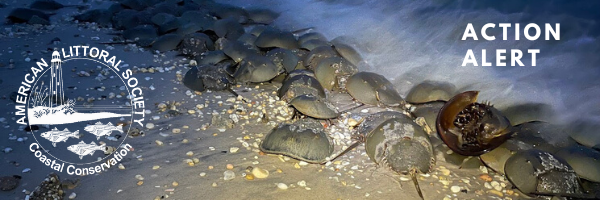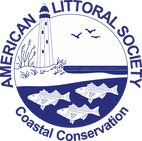|
Horseshoe crabs play a vital role in the Delaware Bay ecosystem, as their eggs provide nourishment for imperiled shorebirds such as the federally threatened Red Knot. Each year, thousands of Red Knots (a bird about the size of an American Robin) fly over 9,000 miles from Tierra del Fuego at the southern tip of South America to breeding grounds in the Arctic Circle. The Delaware Bay is a major stopover point during this long journey, where the Red Knots feast on horseshoe crab eggs in order to gain the necessary weight to have the energy to make it the remainder of the way to the Arctic Circle. The overharvesting of horseshoe crabs by the bait and biomedical industries has put a severe strain on the ecological connection between horseshoe crabs and Red Knots. Fewer spawning crabs means fewer eggs and therefore fewer Red Knots. In 1998, the Atlantic States Marine Fisheries Commission (ASMFC) adopted a fishery management plan for the horseshoe crab harvest. Since the 2013 fishing season, the ASMFC has set harvest quotas using an ARM (Adaptive Resource Management) Framework that links the allowable harvest to the Red Knot stopover population. Each year, the ASMFC has selected the same allowable harvest totals based on this framework, which is 500,000 males and zero females. It was agreed that the prohibition on harvesting female horseshoe crabs would not be lifted until the Delaware Bay region hosts at least 81,900 Red Knots or 11.2 million female horseshoe crabs. Despite the fact that neither of these scenarios has occurred yet, the ASMFC has recently proposed changes that would result in lifting the prohibition on harvesting female horseshoe crabs, further imperiling the food supply for the remaining Red Knots. This is coming at a time when Red Knots are far from stable. The average Red Knot count at Tierra del Fuego for 2018-2020 declined more than 75 percent from average counts in the 1980s and 2000. In 2021, only 6,800 Red Knots were counted, which is by far the lowest count since surveys began. By allowing female horseshoe crabs to be harvested, there will be less available eggs and that will put further strain on an already delicate Red Knot population. You can take action: Urge the ASMFC not to approve this harmful proposal at the ASMFC 2022 Summer Meeting on Wednesday, August 3, 2022.
Register for the webinar at https://attendee.gotowebinar.com/register/7218217294868422923 (Webinar ID: 822-004-851). If you are joining the webinar but will not be using VoIP, you can may also call in at +1 (415) 655-0060, access code 636-403-362. A PIN will be provided to you after joining the webinar; see webinar instructions for details on how to receive the PIN. For those who will not be joining the webinar but would like to listen in to the audio portion only, press the # key when asked for a PIN. Comments can also be submitted via email at [email protected]. The following is the text of the letter submitted by Tim Dillingham, Executive Director of the Littoral Society, to ASMFC Horseshoe Crab Management Board regarding the proposed changes: August 2, 2022 Mr. John Clark, Chair Horseshoe Crab Management Board Atlantic States Marine Fisheries Commission Mr. Clark, I am writing to express the deep concerns of the American Littoral Society, the New Jersey Audubon Society and the New Jersey Conservation Foundation regarding the possible action by ASMFC at its Summer Meeting of the Horseshoe Crab Management Board to substantially modify the policies and approaches to protecting the crabs and red knots of Delaware Bay through a highly-technical modification to the Adaptive Resource Model (ARM) utilized by the Commission, through the initiation of Addendum VIII. The impact of the central parts of the revisions – to change the harvest restrictions and reopen the bait fishery’s access to female horseshoe crabs despite the lack of recovery to date of the red knot populations which depend on the eggs they produce – is buried under hundreds of pages of technical discussions. Leading members of the ASMFC’s own advisory committee have tried raise this concern to the primacy it deserves, and even the Peer Review Committee urged caution. Further, this fundamental change in policy and risk to the recovery of the red knot is being done behind the closed doors of the modeling committees without robust and engaged public consideration of the acceptability of the risk to important stakeholders including the broader public and conservation community. Requests by leading members of the conservation and environmental communities for access to the models have been denied. Even the outside Peer Review Committee raised concerns about the shift in policy embedded in technical changes and the adequacy of how well public and stakeholder concerns were taken into account. I doubt that the public’s tolerance to the possibility of red knot extinction is as high as this new ASMFC direction envisions. In the Peer Review report, the experts advised: “Because the changes would lead to harvest of female HSC, which has been restricted since the implementation of the original ARM Framework, the Panel cautions the [Working Group] to fully consider if the new reward function truly represents the values articulated by stakeholders in the 2009 ARM Framework.” I strongly urge the Commission to not approve the proposed Framework Revision before you for consideration on August 3, 2022. Under the current framework, no female crabs can be harvested in Delaware Bay for bait until the female population reaches 11.2 million crabs or the total red knot stopover population reaches 81,900 birds. Neither metric has yet been attained. Under the proposed management revision, 175,000 to 190,000 females could be harvested as soon as 2023, according to some experts. In reaching this decision, the ASMFC disproportionately relied on surveys it has long considered biased and of dubious accuracy, which “reduces the scientific credibility” of the proposed revision, according to committee members and former proponents of the ARM framework (Niles, Burger, Mizrahi, & Dey, 2021). The only horseshoe crab-specific survey thought historically reliable—the Virginia Tech trawl survey—continues to indicate that female horseshoe crabs are in trouble. I would request that the Board hold the draft addendum until it can be amended to reinclude the original, stakeholder based protections regarding recovery levels prior to reopening female crab harvest, and that the fundamental modeling and other technical analyses foundational to the addendum’s recommendations be publicly shared and fully made available and reviewed by interested stakeholders. Thank you for your attention to these comments. Sincerely, Tim Dillingham, Executive Director On behalf of: Alex Ireland, President and CEO New Jersey Audubon Society Dr. Emile DeVito, Director of Conservation Science New Jersey Conservation Foundation 8/4/2022 02:41:02 pm
Please help save our horseshoe crabs which will save our Red Knots. Comments are closed.
|
Archives
July 2024
Categories
All
|


